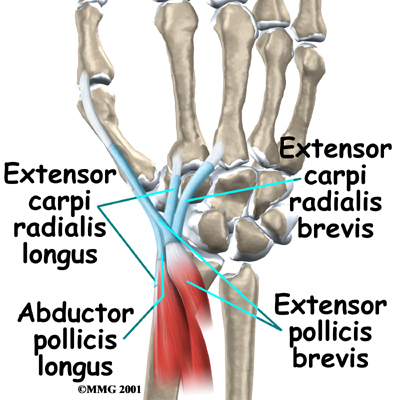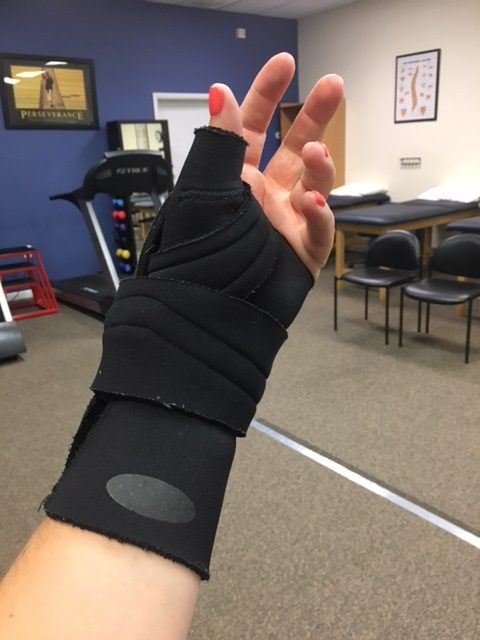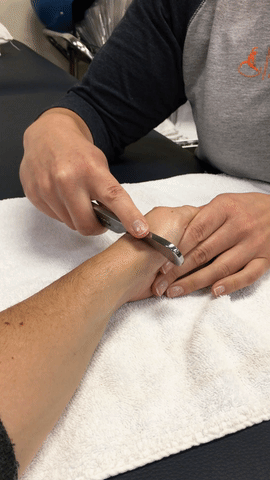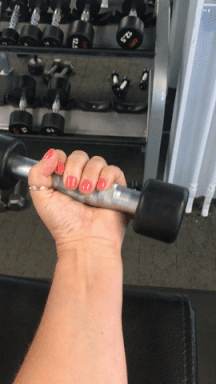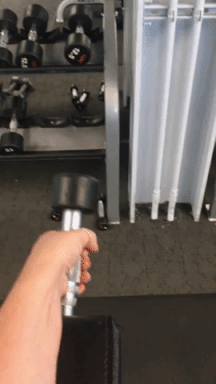Several months ago while on vacation, I had a bad bike accident. I was riding on a rocky, unpaved road and hit a big rock. I went flying off my bike and hit the ground hard! Severe burning and pain to my right hip quickly ensued, but I was able to stand up and walk around, so I thought to myself, “at least I didn’t break a bone.” There was a cantaloupe sized hematoma on my right hip, both hands were scraped up and bleeding, and my chest was also bruised.
I spent the next several weeks taking it easy. My hip was the primary concern because of the swelling, tenderness, and bruising. Even sitting was painful. After a few weeks of rest and with the swelling in my hip mostly gone, I slowly resumed my routine of yoga 2-3 times per week. However, when I went back to weight bearing through my hands, the pain in my wrist was exacerbated.
After each yoga class, my wrist would swell and remain painful despite adequate rest and stretching in between each class. I wondered, “Could I have more seriously injured myself than I originally thought?” Looking back now, I think I had been so concerned with my hip that I had ignored my wrist. Enough was enough and I decided to get my wrist examined.
The Urgent Care facility performed an x-ray and stated that I did not have a fracture. I was relieved. They prescribed a generic brace for my hand, told me to rest, and instructed me to follow up with an orthopedic surgeon in 2 weeks if my symptoms did not subside.
Now for me, wrist rest is relevant. I work full time as a physical therapist. Much of my job consists of performing manual therapy techniques, massage, and typing notes. I considered rest as taking a break from yoga. I kept up my work activities and never fully rested from all my usual work activities.
Needless to say, my symptoms did not go away. I scheduled an appointment with an orthopedic hand specialist. At this point I was frustrated with the constant pain, swelling, and inability to participate in the exercise routines I loved.
The surgeon reviewed the x-rays that I had from 2 weeks earlier at the urgent care center. She asked where my wrist pain was and zoomed in on the x-ray region of the area I had been complaining about. Noting the changes in cortical bone at my radial styloid, she said “It looks like you fractured your wrist but it is healing well.” She further explained that the pain and swelling I was experiencing was from De Quervain’s tendonitis, an inflammation of the tendons of the muscles that control my thumb movement. She recommended a corticosteroid injection to help with the inflammation and a more restrictive brace that limited all thumb movement. I was told to wear the brace and abstain from any lifting and weight bearing with my left hand for 3 weeks.
I initially followed her instructions because I was tired of being in pain but I also felt restless. My exercise routine was limited, the brace annoyed me and I was constantly uncomfortable. In my last 10 years of practicing as a physical therapist, I have never felt more closely connected to the frustration that my patients must feel when they experience injury and loss of function. This injury really hit home for me.
Turns out, I’m a good physical therapist but a terrible patient.
I was feeling good after following the doctor’s instructions, for about a week, so I went back to weightbearing activities and yoga. Two yoga classes later, my wrist swelled up and I was back to the pain I started with. I attempted to rest my wrist again but the pain persisted. A new orthopedic doctor prescribed another set of anti inflammatory injections and diagnosis me with extensor carpi radialis tendinitis. This time, I was told that if it did not get better with rest and injections, surgery to release my tendon sheath was the next option.
(Image via eorthopod.com)
Surgery is not an option for me. Through my experience as a therapist, I know that there are often complications with surgery including; risk for infection, loss of mobility, loss of time at work and exercise. Physical therapy, rest, and bracing is the only option for me. So this time, I am determined to be a good patient, rest adequately and avoid weight bearing exercises for a long time.
Surgery is not an option for me.
My Healthy Wrist Routine
I want to share my healthy wrist program to empower others that may be suffering from wrist tendinitis. I believe in physical therapy. I have seen it drastically improve many of my patient’s injuries. This is how I treat my wrist pain but keep in mind, this program is customized to my injury. If you have a wrist injury (or any kind of injury), it is best to discuss with a physician or physical therapist with a direct access degree.
It begins with a dip in the paraffin bath:
Paraffin is a melted wax bath that I dip my hands into. Because wax has a different specific heat than water, I can use the wax that is 127 degrees F without burning myself. Heating the tissue improves circulation and relaxes my hand and wrist, which are usually stiff and painful.
Next, I have a Physical Therapist perform manual therapy on my wrist with the assistance of Graston tools. The therapist uses these stainless steel instruments with beveled edges to detect any tissue adhesion. The abnormal areas are treated with a massage-like motion using these Graston tools. This helps relieve pain and increase flexibility. I usually experience tremendous increase in range of motion of my wrist after this procedure, which is only about 10 minutes long.
Next I like to stretch while my muscles and tendons are warmed up from the parrafin bath and Graston technique.
My favorite stretches are the Finklestein’s stretch, which stretches my thumb muscles and tendons. I hold this stretch for 10 seconds and repeat 10 times.
I also use the prayer stretch to improve my wrist extension motion. Because this is often the most painful motion for me, I make sure to stop before any pain so that I do not aggravate my symptoms.
I hold this stretch 10 seconds and repeat 10 times.
Next I do some strengthening exercises.
I use 3 lb weights to strengthen my wrist flexors, extensors and radial deviators. I do 3 sets of 10 reps with each exercise.
Because I’m not able to participate in yoga, I want to include some non-weightbearing triceps exercises in my routine so I do not lose any muscle mass. Increased triceps strength can also help offload some of the stress my wrists experience during weight-bearing activities, such as yoga. Proper conditioning is essential to making a seamless and painless return to the activities you love.
These are my two favorites> I perform 3 sets of 10 with each and use 50 lbs.
I also make sure that I get in some cardio each day. With any kind of injury to the extremities, getting adequate circulation is key. My favorite is jogging. It does not matter what kind of cardio activity you do, as long as you get your heart rate up.
Activity Modification
The most important aspect of my rehab process is to avoid flaring up my tendons again. I do not want to keep getting injections in my hand or have surgery, so for now all weight bearing exercises are off limits. I’m also wearing a thumb spica brace at all times, including when I sleep, to further assist in protecting my tendons. I am trying to limit other activities that can hurt my wrist, such as performing manual therapy and typing. Though I cannot completely stop these activities, I’m trying to take breaks more frequently and ask my coworkers for more assistance while I heal.
When I first was injured, I was pretty bummed out. It was scary and frustrating to think about the potential disruptions in my life and work. But now I am looking at this injury as an opportunity. I will use this injury to try new exercise routines and hopefully help me relate to my patients better. I am a week into my healthy wrist program and I already feel better. Sometimes great things can happen when the therapist becomes the patient.


